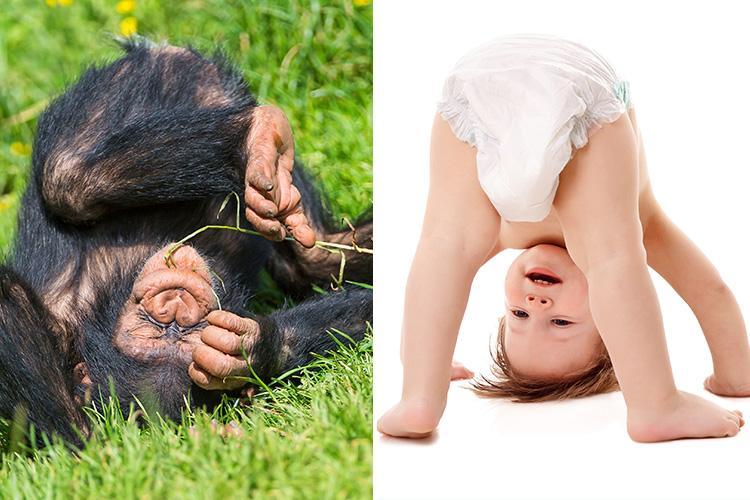Most parents of young children will have referred to their troublesome toddlers as "little monkeys" at some point or another.
大多数父母会把他们处在某个特定阶段的、淘气的孩子叫做“小猴子”。
But an eye-opening new study has actually confirmed that young children are "just tiny apes" who share exactly 96 per cent of their mannerisms with monkeys.
但一项令人大开眼界的新研究证实,幼童“就是小类人猿”,两者有96%的动作相同。
Researchers at the University of St. Andrews in Scotland found that toddlers use a variety of gestures similar to chimpanzees and gorillas when they're first learning to communicate.
苏格兰圣安德鲁斯大学的研究人员发现,幼童刚开始学说话时,他们用一系列的手势和身体动作来作为交流手段,就像黑猩猩和大猩猩那样。
From stamping their feet to shaking their heads, the study (published in Animal Cognition) found that children aged between one and two years old rely on precisely 52 gestures to convey their emotions.
发表在《动物认知》杂志上的这项研究发现,一岁到两岁的幼童会做出跺脚、摇头等52种动作来表达他们的情感。
And out of these movements, 50 of these gestures are also shared with apes. So before children have learnt to communicate their needs through language, it now appears they rely on our evolutionary past to get their feelings across.
他们发现,其中有50种动作与类人猿相同。这表明,在孩子们学会用语言表达他们的需求之前,他们已经依靠我们在进化史上的动作来表达他们的感受。
Dr Catherine Hobaiter from the St Andrews School of Psychology and Neuroscience said: "Wild chimpanzees, gorillas, bonobos and orangutans all use gestures to communicate their day-to-day requests."
圣安德鲁斯大学心理学与神经科学学院的凯瑟琳·霍贝特博士说:“野生黑猩猩、大猩猩、倭黑猩猩和红毛猩猩都会用各种动作来进行日常交流。”

But before this groundbreaking new research, young children have never before been directly studied in relation to apes.
但在这项开创性的新研究之前,幼童与猿类的关系从未被直接研究过。
Dr Hobaiter added: "We used exactly the same approach to study young chimpanzees and children, which makes sense -- children are just tiny apes."
霍贝特博士补充称:“我们用同样的方法研究年幼的黑猩猩和人类幼童,这是有道理的--幼童就是小类人猿。”
Examining children in both their nursery and home environments, researchers then compared the toddlers' gestures to those used by chimpanzees in their natural habitat in Uganda.
研究人员对托儿所和家庭中的儿童进行了研究,然后将这些幼儿的动作与乌干达黑猩猩在自然栖息地使用的手势进行了比较。
And while apes have over 80 gestures, which they use to communicate with each other, researchers were surprised by the overlap between young tots and chimpanzees.
类人猿使用超过80种不同的动作来交流,研究人员对幼童和黑猩猩之间动作的重叠现象感到惊讶。
For instance, both toddlers and chimpanzees rely on specific gestures to indicate they want attention. What's more, young children also depend upon certain movements (such as touching a person's face) to communicate when they want to be picked up or followed just like monkeys.
例如,幼儿和黑猩猩都依赖特定的手势来表示他们想要被关注。此外,小孩也用某种动作(比如摸人的脸)来表示自己想要被抱起来或者被人跟随。
Dr Hobaiter said: "We thought that we might find a few of these gestures -- reaching out your palm to ask for something or sticking your hand up in the air -- but we were amazed to see so many of the 'ape' gestures used by the children."
霍贝特博士表示:“我们以为可能会发现少数这样的动作--伸出手索要东西或将手举起来--但我们惊讶地看到孩子们做出'类人猿'的很多动作。”


